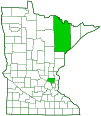Poplar’s snout weevil
(Lepyrus palustris)
Conservation • Description • Habitat • Ecology • Distribution • Taxonomy
|
|
||||||||||||||
Description |
Poplar’s snout weevil is a medium to large sized weevil. The male is about ½″ long. The female is larger, just under ⅝″ long. In Europe and Asia this species is considered a pest because it damages basket willow, a cultivated plant. The body is black and is sparsely covered with gray and yellowish hair-like scales. The thorax is short, cone-shaped, and significantly narrowed in front. It is composed of three segments. The first segment (prothorax) is large and prominent and appears to be the entire thorax. It is covered by a saddle-shaped plate (pronotum). The pronotum is 1¼ times longer than wide and 1½ times wider at the base than at the apex (near the head). It is coarsely and densely wrinkled and pitted. The base and apex are straight across, not rounded or wedge-shaped. The sides are only slightly rounded. There is a pale slanted stripe on each side. There are two pairs of wings, a membranous inner pair and a hardened outer pair (elytra). The elytra are attached to the second thoracic segment (mesothorax). They are 1½ times longer than wide. They cover the mesothorax, the third thoracic segment (metathorax), and completely cover the abdomen. They are oblong egg-shaped, narrowed toward the tips, and moderately convex. They have a small, pale spot in the middle and are covered with rows of longer, denser, white or yellowish scales. The intervals between the rows of scales finely and densely pitted. The head is greatly elongated between the eyes and the mouth parts form a conspicuous snout. The snout is slightly longer than the thorax. It is slightly bent downward, almost cylinder-shaped, and enlarged toward the tip. It is densely covered with fine pits that are distinct from the base to the tip. The antennae are short and slender. The last 3 segments are expanded and form a club. There are seven jointed segments between the base and the club. The first two segments are long, the second much longer than the first. The third through seventh segments are short. The third leg segment (femur) has a pale ring-like band and is armed with a small tooth on the inner side. The fourth leg segment (tibia) is armed on the inner side near the tip. |
Size |
Total length: ½″ to ⅝″ |
Similar Species |
Habitat |
Deciduous forests |
Ecology |
Season |
Year-round. One generation per year. |
Behavior |
|
Life Cycle |
Adults overwinter. In May or June the female lays 100 to 140 eggs on the ground near a host plant. When the eggs hatch the larvae enter the soil and feed on the roots. They pupate in the soil and emerge in July as adults. |
Larva Food |
Roots of soft trees, including willow (Salix), sassafras (Sassafras), and poplar (Populus). |
Adult Food |
Leaves of soft trees, including willow (Salix), sassafras (Sassafras), and poplar (Populus). |
Distribution |
||
|
Sources |
|
| 8/15/2025 | ||
Occurrence |
||
Uncommon |
||
Taxonomy |
|
Order |
Coleoptera (Beetles) |
Suborder |
Polyphaga (Water, Rove, Scarab, Long-horned, Leaf, and Snout Beetles) |
Infraorder |
Cucujiformia |
Superfamily |
Curculionoidea (snout and bark beetles) |
Family |
Curculionidae (true weevils) |
Subfamily |
Molytinae |
Genus |
Lepyrus |
Subordinate Taxa |
|
|
|
Synonyms |
|
Curculio bipunctatus Curculio colon Curculio palustris Lepyrus geminatus Lepyrus pinguis |
|
Common Names |
|
Poplar’s snout weevil |
|
Glossary
Elytra
The hardened or leathery forewings of beetles used to protect the fragile hindwings, which are used for flying. Singular: elytron.
Femur
On insects and arachnids, the third, largest, most robust segment of the leg, coming immediately before the tibia. On humans, the thigh bone.
Pronotum
The exoskeletal plate on the upper side of the first segment of the thorax of an insect.
Prothorax
The first (forward) segment of the thorax on an insect, bearing the first pair of legs but not wings.
Tibia
The fourth segment of an insect leg, after the femur and before the tarsus (foot).
Visitor Photos |
||
Share your photo of this insect. |
||
This button not working for you? |
||
Bill Reynolds |
 |
This weevil is a parasite of softwood forest. In the area I found the weevil, Poplar trees are everywhere. |
MinnesotaSeasons.com Photos |
||
|
||
|
||

Slideshows |
|

Visitor Videos |
||
Share your video of this insect. |
||
This button not working for you? |
||
|
Other Videos |
||
|

Visitor Sightings |
||
Report a sighting of this insect. |
||
This button not working for you? |
||
| Bill Reynolds 8/4/2003 |
Location: St. Louis Co. This weevil is a parasite of softwood forest. In the area I found the weevil, Poplar trees are everywhere. |
 |
MinnesotaSeasons.com Sightings |
||
|

Created: 11/4/2013 Last Updated: © MinnesotaSeasons.com. All rights reserved. |
